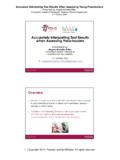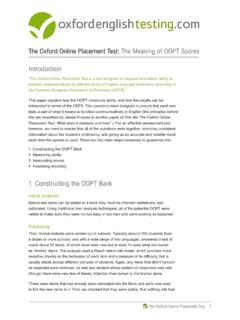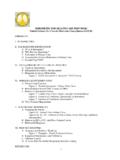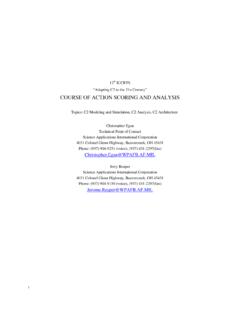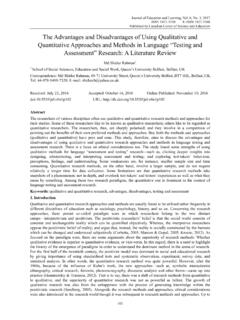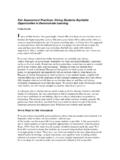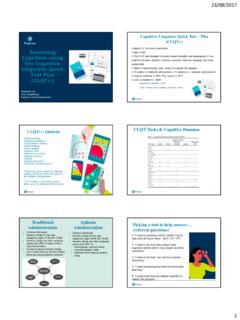Transcription of Research on Classroom Summative Assessment
1 235 Assessment is unquestionably one of the teacher s most complex and important tasks. What teachers assess and how and why they assess it sends a clear message to students about what is worth learning, how it should be learned, and how well they are expected to learn it. As a result of increased influences from external high stakes tests , teachers are increasingly working to align their CAs with a continuum of benchmarks and standards, and students are studying for and taking more CAs. Clearly, high-stakes external tests shape much of what is hap-pening in classrooms (Clarke, Madaus, Horn, & Ramos, 2000). Teachers design assessments for a variety of purposes and deliver them with mixed results . Some bring students a sense of success and fairness, while others strengthen student per-ceptions of failure and injustice. Regardless of their intended purpose, CAs directly or indirectly influence students future learning, achievement, and motivation to learn.
2 The primary purpose of this chapter is to review the literature on teachers Summative Assessment practices to note their influence on teachers and teaching and on students and learn-ing. It begins with an overview of effective sum-mative Assessment practices, paying particular attention to the skills and competencies that teachers need to create their own assessments, interpret the results of outside assessments, and accurately judge student achievement. Then, two recent reviews of Summative Assessment prac-tices are overviewed. Next, the chapter reviews current studies of Summative CAs illustrating common Research themes and synthesizing pre-vailing recommendations. The chapter concludes by drawing conclusions about what we currently know regarding effective CA practices and high-lighting areas in need of further the Context: The Research on Summative Classroom Assessments Assessment is a process of collecting and inter-preting evidence of student progress to inform reasoned judgments about what a student or group of students knows relative to the identi-fied learning goals (National Research Council [NRC], 2001).
3 How teachers carry out this pro-cess depends on the purpose of the Assessment rather than on any particular method of gather-ing information about student progress. Unlike assessments that are formative or diagnostic, the purpose of Summative Assessment is to determine the student s overall achievement in a specific area of learning at a particular time a purpose that distinguishes it from all other forms of Assessment (Harlen, 2004). The accuracy of Summative judgments depends on the quality of the assessments and 14 Research on Classroom Summative AssessmentConnie M. Moss236 SECTION 4 Summative Assessmentthe competence of the assessors. When teachers choose formats ( , selected-response [SR], observation, essay, or oral questioning) that more strongly match important achievement targets, their assessments yield stronger infor-mation about student progress.
4 Test items that closely align with course objectives and actual Classroom instruction increase both content validity and increase reliability so assessors can make good decisions about the kind of consis-tency that is critical for the specific Assessment purpose (Parkes & Giron, 2006). In assessments that deal with performance, reliability and valid-ity are enhanced when teachers specifically define the performance (Baron, 1991); develop detailed scoring schemes, rubrics and proce-dures that clarify the standards of achievement; and record scoring during the performance being assessed (Stiggins & Bridgeford, 1985).Teachers Classroom Assessment Practices, Skills, and Perceptions of Competence Teacher judgments can directly influence student achievement, study patterns, self- perceptions, attitudes, effort, and motivation to learn (Black & Wiliam, 1998; Brookhart, 1997; Rodriguez, 2004).
5 No serious discussion of effec-tive Summative CA practices can occur, there-fore, without clarifying the tensions between those practices and the Assessment competencies of Classroom teachers. Teachers have primary responsibility for designing and using summa-tive assessments to evaluate the impact of their own instruction and gauge the learning progress of their students. Teacher judgments of student achievement are central to Classroom and school decisions including but not limited to instruc-tional planning, screening, placement, referrals, and communication with parents (Gittman & Koster, 1999; Hoge, 1984; Sharpley & Edgar, 1986). Teachers can spend a third or more of their time on Assessment -related activities (Plake, 1993; Stiggins, 1991, 1999). In fact, some esti-mates place the number of teacher-made tests in a typical Classroom at 54 per year (Marso & Pigge, 1988), an incidence rate that can yield billions of unique testing activities yearly world-wide (Worthen, Borg, & White, 1993).
6 These activities include everything from designing paper pencil tests and performance assess-ments to interpreting and grading test results , communicating Assessment information to various stakeholders, and using Assessment infor-mation for educational decision making. Through-out these Assessment activities, teachers tend to have more confidence in their own assessments rather than in those designed by others. And they tend to trust in their own judgments rather than information about student learning that comes from other sources (Boothroyd, McMorris, & Pruzek, 1992; Stiggins & Bridgeford, 1985). But is this confidence warranted? The CA literature is split on teachers ability to accurately summarize student achievement. Some claim that teachers can be the best source of student achievement information. Effective teachers can possess overarching and compre-hensive experiences with students that can result in rich, multidimensional understandings (Baker, Mednick, & Hocevar, 1991; Hopkins, George, & Williams, 1985; Kenny & Chekaluk, 1993; Meisels, Bickel, Nicholson, Xue, & Atkins-Burnett, 2001).
7 Counterclaims present a more skeptical view of teachers as accurate judges of student achievement. Teacher judgments can be clouded by an inability to distinguish between student achievement and student traits like perceived ability, motivation, and engagement that relate to achievement (Gittman & Koster, 1999; Sharpley & Edgar, 1986). These poor judgments can be further exacerbated when teachers assess students with diverse backgrounds and characteristics (Darling-Hammond, 1995; Mart nez & Mastergeorge, 2002; Tiedemann, 2002). A Gap Between Perception and CompetenceFor over 50 years, the CA literature has docu-mented the gap between teachers perceived and actual Assessment competence. Teachers regu-larly use a variety of Assessment techniques despite inadequate preservice preparation or in-service professional development about how to effectively design, interpret, and use them (Goslin, 1967; O Sullivan & Chalnick, 1991; Roeder, 1972).
8 Many teachers habitually include nonachievement factors like behavior and atti-tude, degree of effort, or perceived motivation for the topic or assignment in their Summative assessments. And they calculate grades without weighing the various assessments by importance (Griswold, 1993; Hills, 1991; Stiggins, Frisbie, & Griswold, 1989). When they create and use Chapter 14 Research on Classroom Summative Assessment 237performance assessments, teachers commonly fail to define success criteria for the various lev-els of the performance or plan appropriate scoring schemes and procedures prior to instruction. Moreover, their tendency to record their judg-ments after a student s performance rather than assessing each performance as it takes place consistently weakens accurate conclusions about how each student performed (Goldberg & Roswell, 2000).
9 In addition to discrepancies in designing and using their own assessments, teachers actions during standardized testing routinely compro-mise the effectiveness of test results for accu-rately gauging student achievement and informing steps to improve it. Teachers often teach test items, provide clues and hints, extend time frames, and even change students answers (Hall & Kleine, 1992; Nolen, Haladyna, & Haas, 1992). Even when standardized tests are not compromised, many teachers are unable to accurately interpret the test results (Hills, 1991; Impara, Divine, Bruce, Liverman, & Gay, 1991) and lack the skills and knowledge to effectively communicate the meaning behind the scores (Plake, 1993). Incongruities in teachers Assessment prac-tices have long been attributed to a consistent source of variance: A majority of teachers mistakenly assume that they possess sound knowledge of CA based on their own experi-ences and university coursework (Gullikson, 1984; Wise, Lukin, & Roos, 1991).
10 Researchers consistently suggest collaborative experiences with assessments as a way to narrow the gap between teacher perceptions of their assess-ment knowledge and skill and their actual Assessment competence. These knowledge-building experiences develop and strengthen common Assessment understandings, quality indicators, and skills. What s more, collabora-tion increases professional Assessment lan-guage and dispositions toward reflecting during and after Assessment practices events to help teachers recognize how assessments can pro-mote or derail student learning and achieve-ment (Aschbacher, 1999; Atkin & Coffey, 2001; Black & Wiliam, 1998; Borko, Mayfield, Marion, Flexer, & Cumbo, 1997; Falk & Ort, 1998; Gearhart & Saxe, 2004; Goldberg & Roswell, 2000; Laguarda & Anderson, 1998; Sato, 2003; Sheingold, Heller, & Paulukonis, 1995; Wilson, 2004; Wilson & Sloane, 2000).










